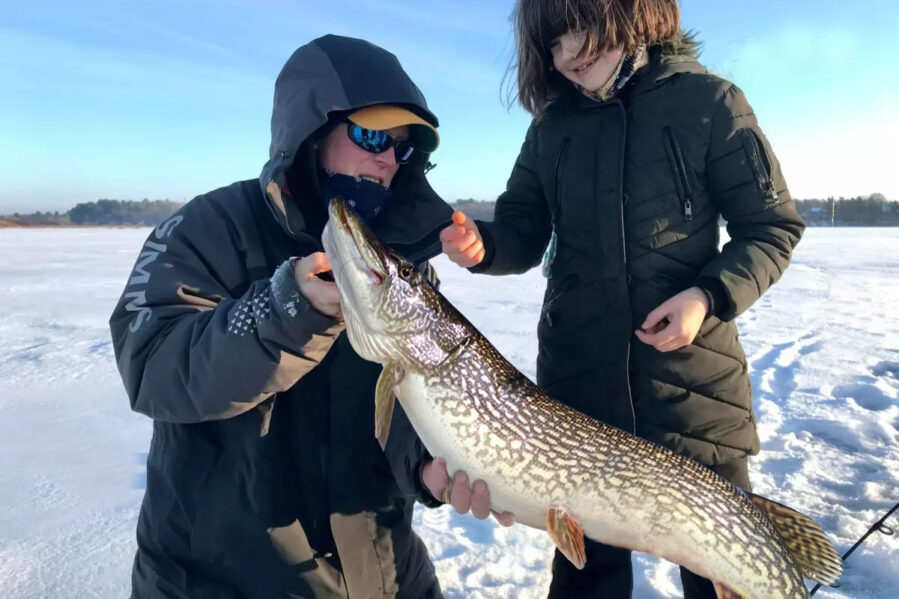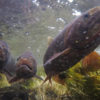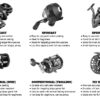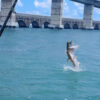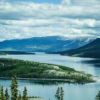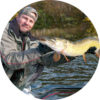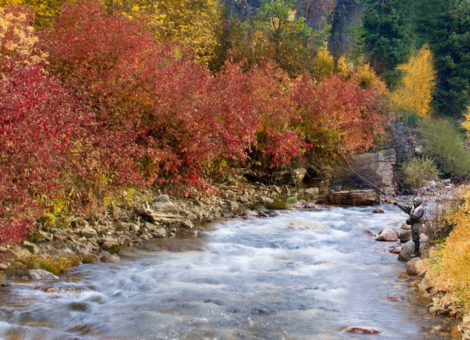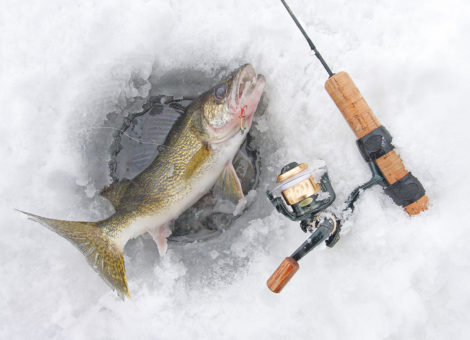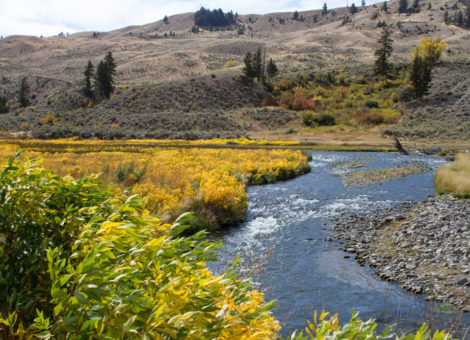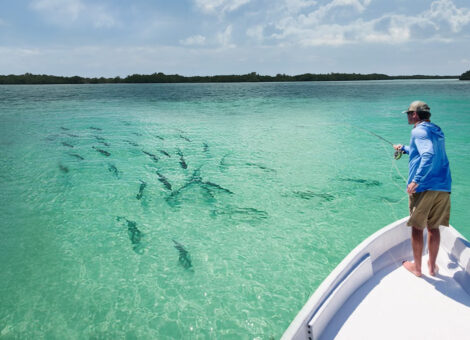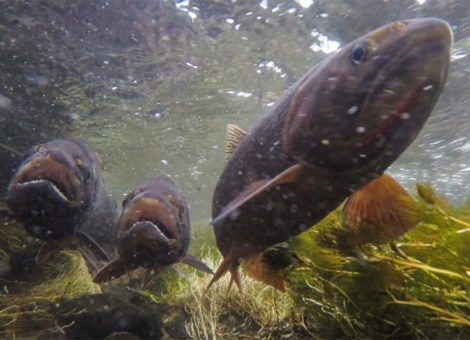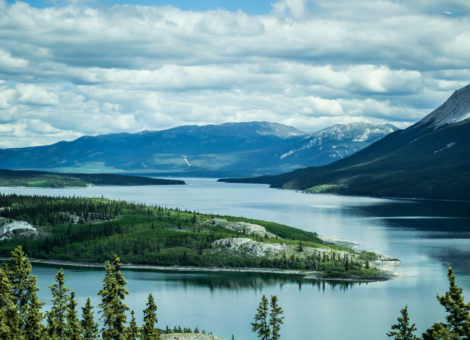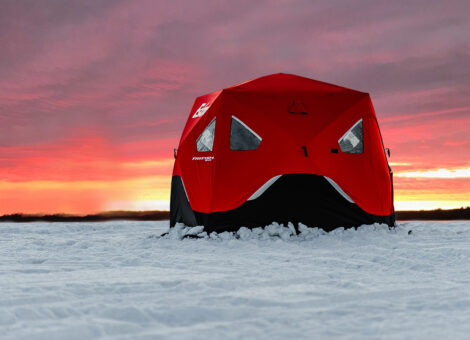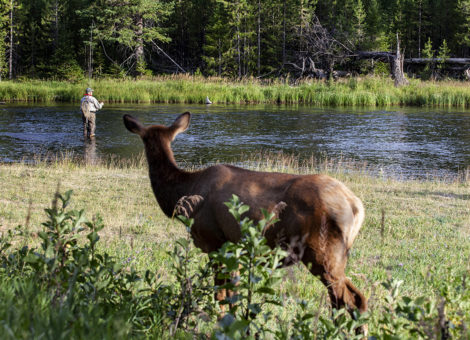With over 65,000 miles of shoreline, 14,552 islands and 47 fish species, Lake of the Woods is the largest, most productive, inland freshwater fishery in the U.S. next to the five Great Lakes. And with 3 to 4 foot thick ice during the winter—and one of the longest ice fish seasons in the upper Midwest—Lake of the Woods offers a truly unique winter wonderland of opportunity for the avid ice angler.
I’ve done a lot of hard water fishing over the years—at a lot of lakes—and there’s no question Lake of the Woods is at the top of my list of hard water fisheries. One of the reasons I enjoy this lake so much is the diversity. Every time I fish Lake of the Woods it feels like I’m fishing the lake for the first time. You could fish this lake every winter and experience a new favorite fishing spot each time you visit.
You’ll find fish anywhere from just a couple hundred yards from the bank up to 20 miles offshore. And let me tell ya, when you’re fishing 20 miles offshore during the dead of winter it’s like your on a different planet. Probably no surprise that I fish Lake of Woods for the Walleye—as do most anglers. The walleye fishing here is second to none. But with the right presentation you can catch Northern Pike, Perch, Crappie, Burbot (Eelpout), Sauger and Lake trout.
- Top Ice Fishing Catches
- Best Baits and Techniques by Species
- When to Go Ice Fish
- Best Ice Fishing Spots
- Fishing License
- Regulations and Catch Limits
- Rentals, Lodging & Accomodations
Top Ice Fishing Catches and Species
Minnesota, the “Land of 10,000” lakes, is known for its Walleye fishing—and there are several that claim the title of “Walleye Capital of the World”, but I’m partial to Lake of the Woods. For starters, there are countless superb Walleye fishing spots on Lake of the Woods. Obviously, any lake is going to be hit and miss, and if you want to fish Walleye you need to follow the schools, but you’ll find lunker walleye throughout the lake. Average Walleye are over 16″ and about 3-5 pounds, and reeling in a 25 incher—or bigger—weighing in over 8 pounds isn’t uncommon.
The Walleye fishing is what attracts most ice anglers to Lake of the Woods, but Sauger fishing comes in at a close second. Sauger are very similiar to Walleye, in fact, the two fish are often confused. The two distinguishing characteristics are size and marketings. Average size of Sauger is 12-14″ and about 2-4 pounds. Sauger have black dots on their fins absent on Walleye. And Walleye have a black area behind their dorsal fin absent on Sauger. Sauger take the same bait and are often caught when targeting Walleye. You’ll find more Sauger in the deeper areas of the lake.
If you’re looking for a little bit more excitement, ice fishing for Northern Pike on Lake of the Woods is where it’s at. At over 40 inches long and weighing up to 30 pounds, these monsters really put up a fight. Pike can be caught year round on Lake of the Woods but ice fishing for Pike is particularly fun. Later winter is the perfect time for targeting large pike. To preserve the natural population 30- to 40-inch pike must be released, and you can keep only one fish over 40 inches. So get your camera ready!
The following is a list of the hard water game fish you’ll find on Lake of the Woods. (source: MN Dept. of Natural Resources)
| Fish Species | Description |
|---|---|
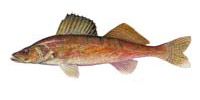 Walleye | Walleye average between 16"-18" but may reach over 25". Average weight is 3-5 lbs but may weigh of 8 lbs. Walleye is the top game fish on Lake of the Woods. |
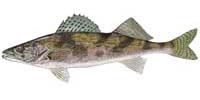 Sauger | Average Sauger are between 12-14" and weigh in at 2-4 pounds. Sauger are similar in appearance to Walleye but a slightly smaller and have different markings. |
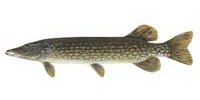 Northern Pike | May reach over 40 inches in length and weigh up to 30 pounds. Pike between 30 to 40 inches must be released. Limit of 3 fish with only one over 40 inches. |
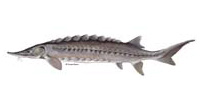 Lake Sturgeon | Large sturgeon are plentiful. Can reach over 75 inches and well over 100 lbs. Allowed 1 harvested sturgon per calendar year between 45"-70" or over 75". |
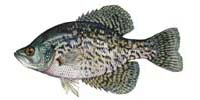 Crappie | Average size of Crappie on Lake of the Woods is 11-12 inches with an occassional catch over 14 inches. Most common in the Northwest Angle and in Ontario waters. |
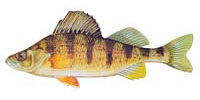 Yellow Perch | Jumbo perch are common. Average size is 10-12" and over 14 inches is not uncommon. Plentiful around the Long Point and Rocky Point areas, as well as Northwest Angle. |
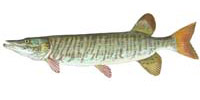 Muskie | World class muskie fishery. Muskies are abundant. May reach 50 inches in length and over 50 lbs. Muskies are catch and release. |
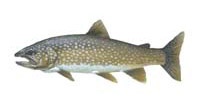 Lake trout | Can reach up to 36" and weigh over 40 pounds. Prefer water between 40 and 55°F. Are abundant in deeper waters including Whitefish Bay and Clearwater Bay. |
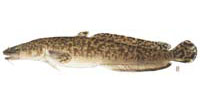 Burbot (Eelpout) | Fresh water cod fish abundant throughout Lake of the Woods. The largest Burbot on record—19lbs 10oz 33 inches—was caught in Lake of the Woods in 2016. |
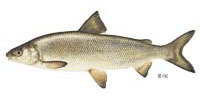 Lake Whitefish | Grow up to 30 inches and 5 pounds. Average 18-20 inches and 3-4 pounds. Similar in appearance to cisco but larger. Most abundant in the Northwest Angle. |
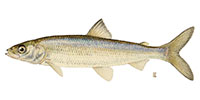 Cisco (Tullibee) | Common ice fishing catch on Lake of the Woods. Relatively small. They average between 10-14 inches and 1/2 to 1 pound, but they can reach over 15 inches in length. |
Best Baits and Fishing Techniques
Ice fishing baits and techniques are as varied as there are fish and anglers. Jigging, deadsticking, fishing rattle baits and dark house spearing are all fun and effective ice fishing methods for catching a variety of fish on Lake of the Woods, but the most effective baits and techniques will really depend on your target species.
If I had to choose only one presentation to ice fish on Lake of the Woods is would be a jig tipped with a minnow. You’ll catch more fish with this simple setup than any other rig. Below I’ll cover the most common—and arguably most effective—baits and fishing methods for ice fishing each species of fish on the Lake of the Woods.
Walleye
If you’re coming to Lake of the Woods to ice fish, you’re probably coming to catch some Walleye—so that’s where we’ll start.
There are variety of methods for fishing walleye under the ice, but first things first. Before you can catch walleye, you have to find them. Target rocky drop-offs, weed edges, humps and transitions where rocky structure turns to soft substrate. These are all common holding locations and great places to drop your line. If you’re not familiar with Lake of the Woods topography, you’ll want to bring a topographic map or a fish finder with mapping capabilities.
In areas of Lake of the Woods where the water is stained with tannins and clarity is low I recommend fishing depths in the 6-12′ range. As water clarity increases move your lines to the 10 to 20-foot depth range, or deeper. You can find Walleye in water as shallow as a few feet and as deep as 30 feet. Drill multiple holes and do some testing.
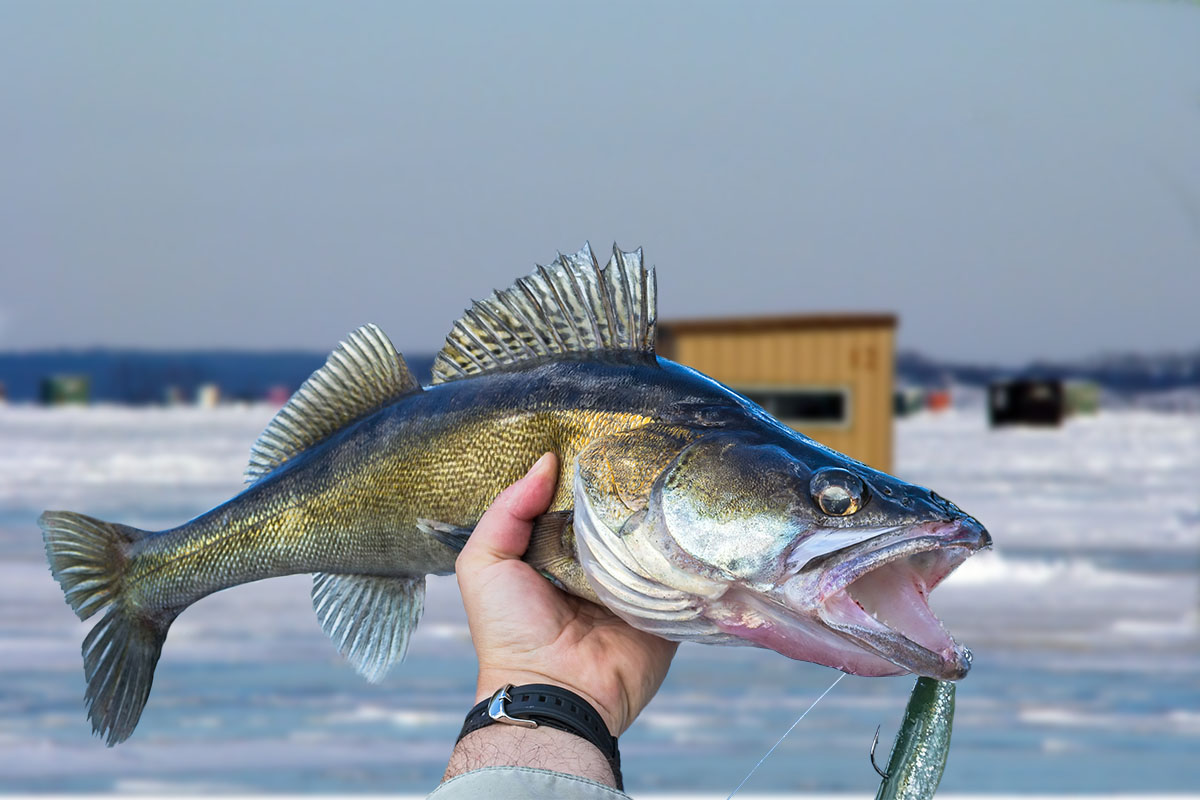
Once you pinpoint structure or transition zones where Walleye are likely holding, drill multiple holes. I recommend drilling as many as 10 to 15 holes—with 5 holes along the top edge of the transition zone, 5 along the middle and 5 more along the deeper end. Jig each hole for about 5-10 minutes until you find fish.
The most effective technique for ice fishing for Walleye is fishing a jig and a minnow on the bottom or within a few feet of the bottom. Alternatively, you can jig a variety of lures that will also entice a strike from a hungry Walleye.
A few proven live baits include flathead minnows, chubs, or golden shiners. You really can’t go wrong with any of these baits. Walleye will take them all. When fishing a minnow, hook it lightly through the upper middle back so that it remains alive and in a natural horizontal position when in the water.
For small to medium fathead minnows, use a #4 or #6 double hook (treble hook with a barb removed) or a single circle hook. A lot of anglers like using a smaller treble hook, but I find them difficult to remove from the fish—especially in freezing conditions. And treble hook can do a lot of damage to the fish if you’re catching and releasing.
The best Walleye spoons and lures are those that resemble minnows and reflect light. When fishing areas of Lake of the Woods with high water clarity use silver colored lures. These are particularly effective during early winter when Walleye are still holding in the shallows.
Much of the southern region of Lake of the Woods is stained water. You’ll want to use brighter colored lures—such as chartreuse—to catch the attenting of Walleye when water clarity is low. For Walleye I recommended using 10-12 pound low visitiblity fluorocarbon leader about 24 to 30 inches long. Walleye can be a bit line shy and you don’t want your presentation to scare them off.
Where water clarity is high, jig your lure 1-2 feet off the bottom. Where water is stained and visibility is low, you should position your lure within 6-12 inches of the bottom and make sure to provide plenty of vertical action when jigging so Walleye can sense your lure.
A popular approach to Walleye fishing on Lake of the Woods and other Minnesota hard-water fisheries is called the “Two Pole”. Drill two holes side by side. In one hole you’re going to deadstick a live bait on a jig or slip bobber. In the second hole you’re going to jig a lure. When fish are active, the jigging line with the lure will be more effective. When Walleye are less active, the deadstick with live bait will out fish the lured jigging line.
Live bait rigs are typically more effective than artificial lures at attracting strikes when Walleye are less active. When a cold front sets in, or oxyen levels are low during the depths of winter, live bait is the best way to go.
Walleye feed more aggressively during low light conditions, which explains why they tend to bite more frequently during dusk and dawn. About an hour just before and after sunset is prime time for Walleye fishing on Lake of the Woods. However, in turbid waters conditions—which are prevalent on much of Lake of the Woods—Walleye fishing can be productive throughout the day.
During the early season Walleye typically hold in shallower 10 to 20 feet of water. I’ve also seen that a lot of fish tend to be on and around mid lake structure toward the beginning of the season. As the season progresses into mid winter, some Walleye will disperse to the deeper flats. As spring returns, they’ll move back into the shallows.
Sauger
Ice fishing for Sauger is very similar to ice fishing for for Walleye. Sauger will take a minnow—or a lure that resembles a minnow—and they feed near the bottom. Many of the same strategies and techniques employed for catching Walleye on Lake of the Woods also work for catching Sauger—including the “Two Pole” approach outlined in the previous section.
The biggest differences between Sauger and Walleye is that Sauger tend to hug the bottom of the lake, are typically found in deeper water, prefer a little current, and are aggressive feeders. Understanding these differences, and a bit about their behavior, can help you to consistently catch sauger—instead of their larger Walleye cousins.
You’ll often find both Sauger and Walleye cohabitating in the same habitat at the same depth. Reeling in a Sauger right on top of a Walleye is proof of this. But it’s also not uncommon to catch scores of walleye in under 10 feet of water and not get even a nibble from a Sauger—which may be close but a bit deeper at 20 to 30 feet. Sometimes you just need to fish a little deeper to hook a Sauger.
Like a Walleye, Sauger will readily take a jig with a minnow. But being a slightly smaller fish, a more compact presentation is all that is required. Bright, bold jigs will catch Saugers as well as Walleye, but I’ve found that a plain standard jig tipped with a minnow head or small shiner will catch just as many Sauger.
When fishing for Sauger you want your bait just off the bottom—at 2 and 4 inches. Walleye also feed on the bottom, but they’ll go up a couple feet to grab an tasty looking bait where Sauger tend to keep their nose down in the dirt. If you’re using the “Two Pole” approach for Sauger you want to twitch your lure or bait around a bit (or just let it suspend), while your deadstick minnow swims along side—with both presentations just few inches off the bottom.
On my lured line, I like to use a rattlebait that creates a vibration sound when jigged down through the ice hole. The rattling sound and vibration will announce its presence to passerbys and attracted nearby fish. Tipping your bait with a minnow will make your presentation that much more attractive.
For jig size, anything between 3/4 to 1 ounce is recommended. If you’re targeting larger Sauger, or going after Walleye in addition to Sauger, you could go with a slightly larger bait. Even though Sauger will take a smaller bait than Walleye, a slightly larger jig may be necessary to get your bait down 30 to 40 feet on the bottom where Sauger are holding. There’s also the current to consider. When there’s current, I’ll use a split shot rig with a couple split shot weights attached just up the line from the jig to get and keep my bait on the bottom.
These tips will help you land more Sauger, but inevitably you’re going to hook a Walleye or two when fishing for Sauger. Just be happy you’re catching fish.
Northern Pike
Minnesota is known for its lakes brimming with trophy pike, but few lakes offer the opportunity to reel in a pike over 40 inches. Late winter on Lake of the Woods is the perfect time to catch one these behemoths. As ice begins to melt in late February, and the days get longer, pike begin to gather in spawning areas where they become vulnerable to ice anglers.
There are big northern pike throughout Lake of the Woods and they rarely get targeted by anglers who have come for the Walleye. If you can find the right spot, and present a bait they recognize, you’ll reel in some monster pike. And don’t forget, big bait rules when going after the big boys.
The go-to presentation for ice fishing pike on Lake of the Woods is the quick-strike rig. The quick-strike is a simple rig made of two treble hooks each attached to a separate wire leader line. The two leader lines are attached to the main line using a #7 swivel with a 50-80 lbs test strength. A single barb of one treble is hooked just behind the head of your live bait. The other just in front of the tail. The idea is that anywhere the pike grabs the bait it will bite an exposed barb.
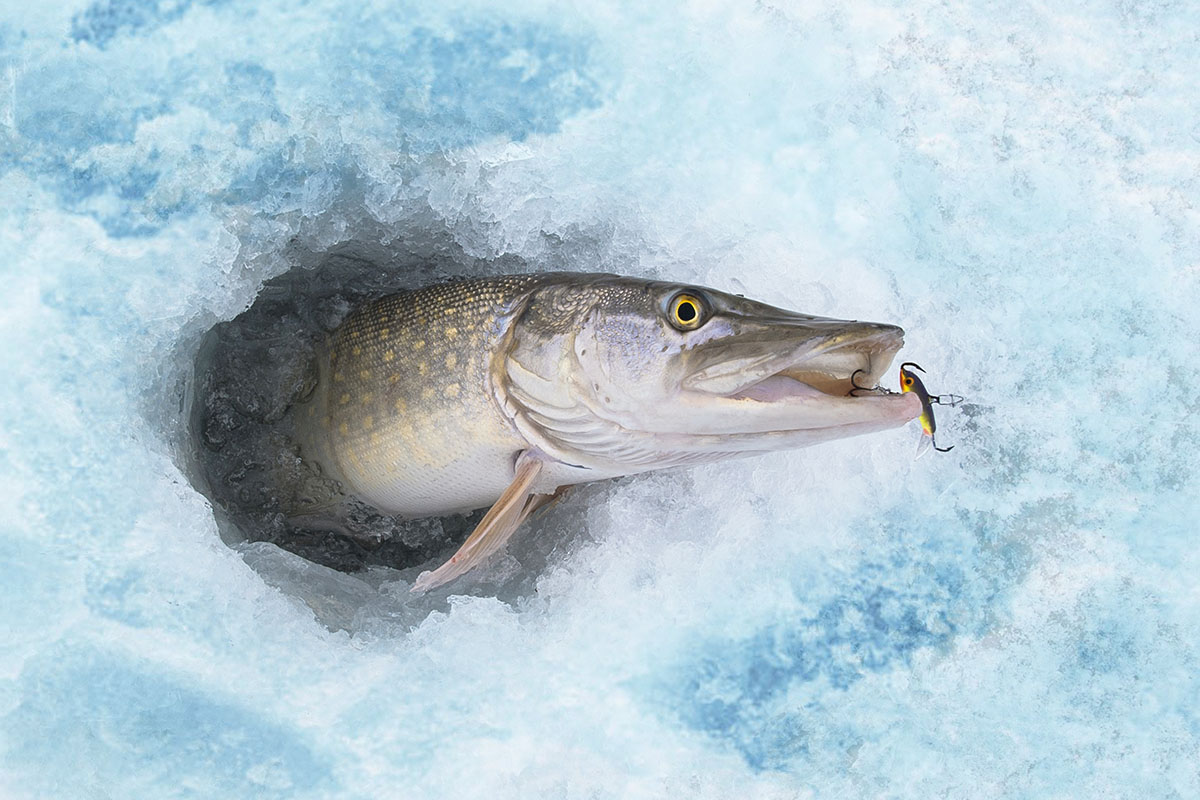
Typically, you’ll use a #6 or #4 treble hook for the quick-strike rig, but optimal hook size will depend on the size of your bait and target fish. Smaller treble hooks tend to produce higher hook rates than larger hooks. However, if you’re targeting extremely large pike, with large bait, I’d recommend going with the little larger #2 treble hook. When a pike grabs your bait, set the hook as soon as you feel the strike.
Above I’ve described a basic two wire quick-strike rig, but there are several variations of this rig that also work well including two trebles inline with one sliding, a loop with both trebles sliding, and a Y type yoke with a treble on each end and a swivel in the middle. The most important part of any quick-strike rig is hook placement. You want your bait fish to be presented horizontally in the water with two of the three barbs on each hook exposed.
The quick-strike rig will work for a variety of predator fish but are primarily used for fishing pike and muskies. If you want to simplify your presentation even more you can fish a circle hook. Where the quick-strike or traditional hook requires a firm tug to get a hookset, the angler doesn’t “set” the circle hook. When the pike takes the bait and swims away the circle hook moves to the corner of the pike’s mouth and lodges.
If you’re practicing catch and release, the circle hook will cause the least amount of damage to the fish. With a quick-strike rig the pike doesn’t typically ingest the entire bait and the hookset occurs in the mouth. But I find that trebles are always more difficult to remove and tend to cause the most damage to the fish.
Pike can be fished under the ice using a traditional ice fishing rod or tip-up. Tip-ups make catching pike easier and more productive. Most experienced pike anglers will use tip-ups. The best thing about using tip-ups is you can set multiple bait lines below the ice, sit back, relax and wait for a strike. When a pike has taken the bait, a flag flips up and you pull the line up through your hole with the pike in tow.
The most common setup for using tip-ups to catch pike is to position your bait about 2-3 feet off the bottom. You can also set your bait right on the bottom. Pike will come up and take your bait in the water column or they’ll grab it off the bottom. Both approaches work. Alternatively, you can drop your bait just below the ice. Large pike often cruise just below the ice looking for a meal.
If you really want to experience Minnesota’s fishing heritage you can try your hand at darkhouse spearing—a technique invented and enjoyed by an older generation pike fisherman. Spearing pike on Lake of the Woods is a little different than spearing on Minnesota’s other lakes. You won’t see as many pike, but the pike you do see are usually big.
Spearing is straight forward. Inside your darkhouse cut a rectangular viewing hole in the ice. Clean out any slush or ice chunks from the hole. Lower a decoy (or bait) into the water to attract northern pike to your viewing hole. Get ready to spear a pike. Actually, there’s a bit more to it, but that’s the gist of it. If it’s your first time spearing, I recommending renting a darkhouse and hiring a guide.
Finally, live bait or dead bait? I’ve found that pike will take either depending on the day. Live bait present more action. Dead bait presents a stinky, easy meal that appeals to many pike.
The most productive time to fish Northern Pike under the ice is during late ice from mid March into April.
Lake Sturgeon
Okay, so we’ve arrived at the grandaddy of grandaddies, giant Lake Sturgeon—and the term “grandaddy” couldn’t be more appropriate. Lake of the Woods sturgeon are large and old. The largest lake sturgeon catch on record was 73 inches long and approximately 120 pounds. A fish that size could be well over 50 years old.
There are a few good ways to target Lake Sturgeon, but there’s one underlying requirement. You’ll need strong rods, reels and fishing lines. These fish are big. They fight hard. And they fight long. Sturdy gear will put less stress on you and sturgeon—and allow you to reel in your catch quicker for a clean catch and release. I also recommend using (1) a conventional reel—maybe a shakespeare or shimano—that can handle a lot of line, as well as (2) a 8-9ft medium to heavy action rod. (I really like the Shimano Tekota 800 reel. It’s a bit pricey, but worth every penny. If you’re on a tight budget the Penn GT 330 is another good reel that’s a bit less expensive.)
A basic sturgeon rig includes a single 18 to 20 inch leader (fluorocabon or wire) attached with a snell knot to a 4/0 to 7/0 circle hook. (You can also use the egg loop knot, which is basically the same knot.) Circle hook size will depend on your target sturgeon size, but you’re typically safe with a 5/0. Sturgeons have a subtle bite. A firm tug is not required for a hookset. After the sturgeon takes the bait, simply tighten your line and move your rod away from the fish. The circle hook will set itself.
As far as line goes, a 60-80 pound test monofilament or braid will work for your main line. I like going with a slightly heavier weight (80+ pound test) for my leader. When river fishing, sturgeon may role up on your line and snap your main if your leader is too short. Not as common with lake sturgeon but I still like to use a heavy leader that’s a bit longer. You can shorten your leader a bit and you’re still boing to be okay.
Attach your leader to your main line using a 3/0 to 6/0 barrel swivel. This swivel size will be rated for well over 200 lbs of strength—plenty strong to reel in a nice size sturgeon. Add a 3-5 ounce no roll sinker above the swivel on your main line. You don’t have to use a no roll sinker for Lake of the Woods but if you’re also going to be fishing Rainy River you’ll want one. You can build your own sturgeon rigs prior to arriving or there are few shops in Baudette where you can buy pre-made sturgeon rigs.
Attach a bait ball made up of nightcrawlers, shinners, and/or minnows to your hook and cast. You’ll fish your rig on the bottom as you would when fishing catfish or carp.
Crappie
The Crappie in Lake of the Woods are not all that difference from Crappie elsewhere in Minnesota’s lakes. They do tend to be a little bit bigger, in the 11-12 inch range with a few jumbos over 14 to 15 inches. They’re also abundant.
You’ll find Crappie throughout the lake but the best Crappie fishing tends to be on the Canadian side. A good Crappie fishing area to target is the territory up around the Northwest Angle.
Crappie tend to hold in deep water holes near structure at a depth of about 30 feet give or take. I try to target any holes near structure or off points, transition areas, and steep breaklines within a reasonable traveling distance by snowmobile.
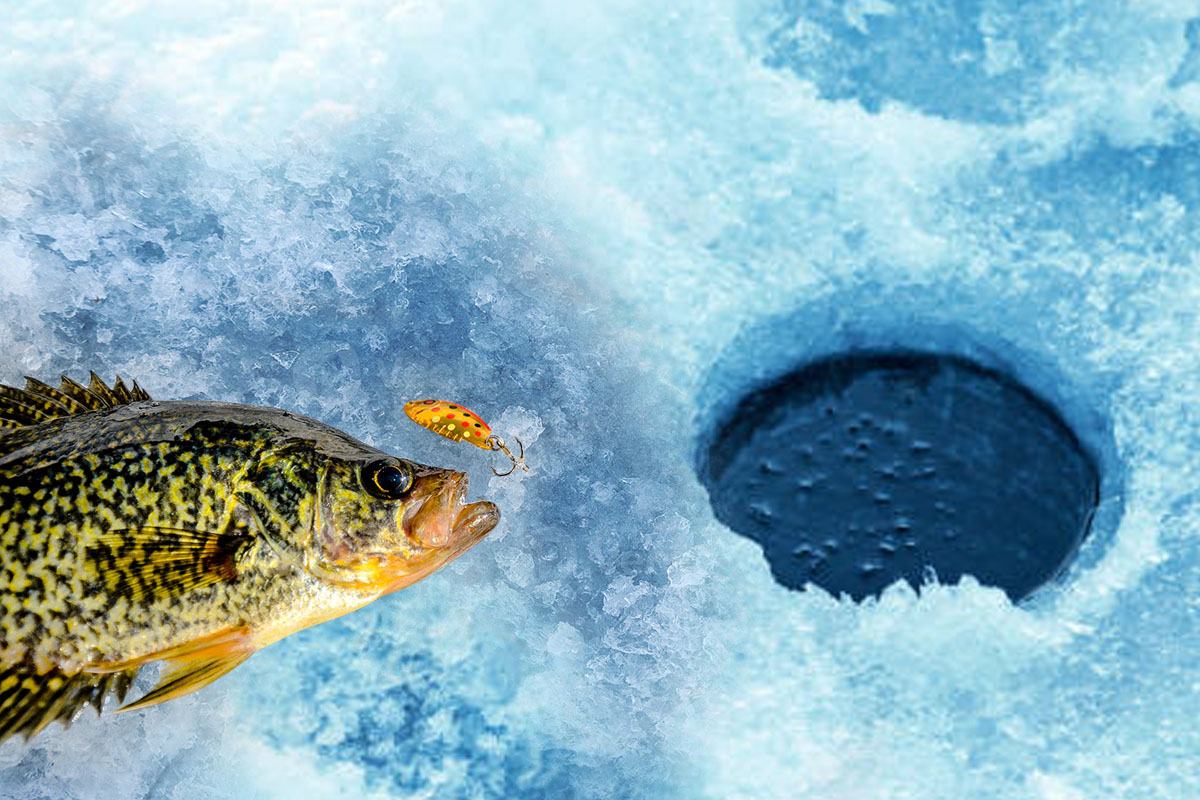
You’ll need a topographical map, or more realistically a good fish finder, that will provide a clear view of the underwater terrain and depth contours. Without a finder you’re really fishing blind. Having said that, I’ve made plenty of fishing trips in the days before electronics and pulled plenty of Crappie through the ice.
The most effective technique for catching Crappie is using a 1/4 to 1/8 ounce lead jig or spoon tipped with a live minnow or minnow head. Crappie also go gaga over bloodworms. Drop your line through your ice hole and jig just off the bottom. For targeting larger Crappie, use larger lures and bait. This will weed out the small fellas.
An effective technique for locating Crappie is “ice trolling” where you drill multiple holes in an area. Fish each hole for about 5 to 10 minutes and keep at it until you start getting bites. Then drill more holes in the area where fish are biting.
Perch
Lake of the Woods is well known for its jumbo size Perch. They’re large and abundant. You can find Yellow Perch throughout the lake. They’re a fun fish to catch and make great tablefare. I find the best ice fishing for Yellow Perch on Lake of the Woods is just after first ice. Try fishing Long Point, Northwest Angle and Rocky Point for jumbos.
Perch are one of the easier fish to catch. Most can be caught on a small walleye jig, perch jig or simple ice spoon. Tip your hook with with a maggot or waxie (waxworm) and you’ll catch even more. A couple of my favorite perch lures for ice fishing are rattle spoons and blade baits. If you only want to target jumbo Perch, use a larger lure. A flutter spoon tipped with a minnow head is a great presentation for targeting large perch.
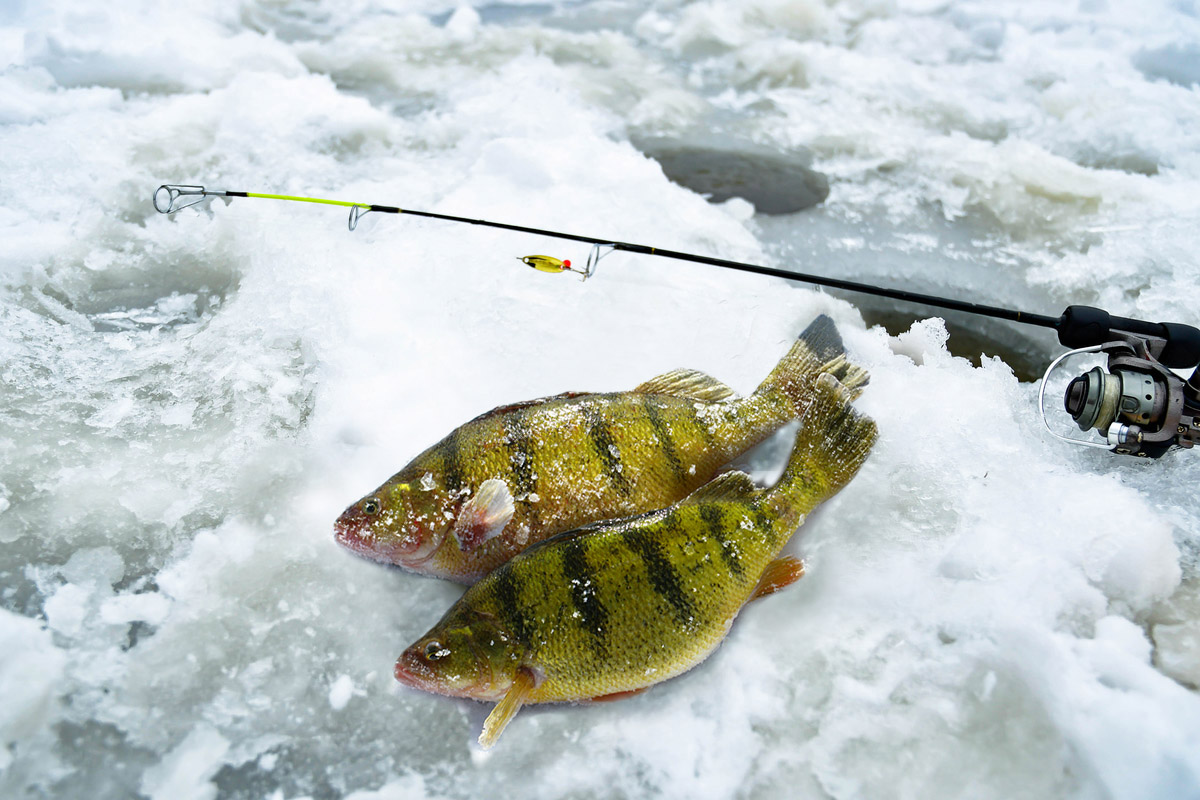
When you just start fishing a hole, drop your lure and bait down onto the bottom and rapidly jig it up and down. This will kick up a bit of sediment and move the water around signaling feeding activity which will attract Perch. Fish your lure just above the cloud of sediment and then work your jig up until it’s a few feet off the bottom. Work your jig up and down slowly. Jig upward for 1-2 feet before working it back down.
Sometimes Perch will be drawn in by an attractive presentation but then get cold feet (or “cold fins”) when it comes to committing to the bite. When this occurs, rig your line with a spoon lure along with another less intimidating bait right below it. The Perch will come in for the lure, but commit to the smaller bait dangling below.
A variation of the “two pole” approached used for fishing Walleye and Sauger will also work for targeting Perch. Drill two holes side by side. In the first hole drop a slip bobber rig with a ball of live waxies or minnows. Lower your bait and set it about 6 inches off the bottom. In the second hole lower your line with a spoon lure. Jig your spoon lure next to your baited line. The flashy lure will draw in the fish while your baited line will catch them. As the frenzy picks up, Perch will begin taking your lures as well.
Muskellunge
While known to most anglers as the “Walleye Capital of the World”, Lake of the Woods is known in other circles as the “Lake of the Muskies.” Lake of the Woods has tremendous muskie populations—and it has big muskies. I consider the lake one the ultimate muskie fishing destinations. Like anywhere, some spots offer better muskie fishing than others, but anywhere on the lake that the fishing is good you’ll find muskies.
Unfortunately, muskie fishing on Lake of the Woods isn’t permitted from December through May. If you catch one while fishing for pike, or another fish, release it immediately or face the potential of a fine.
Lake trout
During the winter, Lake trout fishing on Lake of the Woods is right up there with Walleye in popularity. Your average Lake trout on Lake of the Woods is about 10 to 20 lbs—with some even bigger.
As a deep cold water species, you typically need to drop your lure down 40 feet or more before you get into good Lake trout territory, but during the winter that all changes. With 2-3 feet of ice and a blanket of snow over head, Lake trout are free to rise from the depths and inhabit the entire water column. They’ll even come up to within a few inches of the ice.
Lake trout are typically “bottom-predators”. They routinely lay in weight close to the bottom out of sight. When a school of kokanee, ciscoes, whitefish, or smelt pass overhead, they bolt toward the surface to attack their unsuspecting prey. Alternatively, Lake trout may cruise just under the ice feeding down on their prey. This is why when anglers first drop their rig through their ice hole it’s often hit by a trout before it gets even a few feet.
Under the ice you can find Lake trout at just about any depth from 5 to 150 feet, but they tend to congregate near underwater currents and structure including humps, reefs and points where they’ll wait to ambush drifting prey. Lake trout will also use structure to find baitfish to feed on when prey is scarce in open water.
The key to catching hard-water Lake trout is finding them so you can get them on your bait. Lake trout are always feeding and will concentrate in areas where prey is most abundant. Follow the fish schools and you’ll find Lake trout. Having a good fish finder is a must for locating baitfish schools and Lake trout.
Once you find your mark, get your lure down in the water as quickly as possible. If you can’t get your lure in front of a trout immediately, fish the entire water column in 10 foot increments. Jig your lure a minute or two at each increment and then lower it again.
Lake trout feed on Yellow Perch throughout the winter months. Lure patterns resembling perch are most effective for targeting Lake trout. Fishing a perch-patterned Jigging Rap is a personal favorite. I routinely get hits from larger Lake trout with a jigging rap. Chartreuse coloured tub jigs and soft plastics will also trigger strikes. My buddies that fish Lakers swear that a white 3-4 inche white soft plastic tube bait will put more Lake trout on the ice than any other lure.
Lures with action and a little vibration are effective for catching Lake trout. Any presentation that imitates a dying or wounded fish will attract trout. The Rattl’n Flyer Spoon produces an erractic attention grabbing action irresistable to Lake trout. Jig this spoon at the desired water level snapping it up 2 feet at time and then let it fall back down. The Rattl’n Flyer Spoon produces a flash and vibration that draws trout in from a distance, mimics a wounded baitfish as it free-falls through the water column, and has a natural presentation that will trigger a strike.
If you want to keep it simple and effective, fish an inline spinner. A spinner emits a vibration that draws trout in. For winter fishing under the ice the Lindy 360 jig (1/4 to 3/8-ounce) is a Lake trout killer. This lure can be fished vertically. It flutters downward through the water column like a spoon, and when jigged upward the spinning blade produces a flash and vibration that Lake trout can’t resist. It’s a spinner that I’ve found trout are willing to commit to.
For ice fishing equipment, I recommend using a longer 40 inch rod with plenty of action but a solid backbone. Using a bit heavier 10-pound fluorocarbon or monofilament line will help your lure form a larger circle pattern as it falls through the water column attracting the attention of more fish.
Burbot (Eelpout)
Who fishes for Burbot? On Lake of the Woods, ice fishing for Burbot—also known as Eelpot—is a favorite passtime among local anglers. Ice fishing for Burbot isn’t just popular among local, it draws in Burbot fisherman from across the Midwest. Burbot are usually caught by anglers targeting Walleye, but many anglers specifically target this fish for its white firm flesh.
If Lake of the Woods could possibly be considered another fishing capital of the world, it would be the “Burbot Capital of the World”. I don’t know of another lake that provides such a vast and productive Burbot fishery as Lake of the Woods.
Burbot are cold water fish that typically inhabit the deep waterways in many of Minnesota’s larger lakes—including Lake of the Woods. They’re rarely caught during the warm summer months, but are a perfect target for mid-winter hard-water fishing.
The best time to target Burbot is just before or after sunset. During daylight hours fish the 45-55′ range near the deepest holes. Toward the later evening target the base of dropoffs, breaklines, and typical Walleye structure. When fishing Burbot at night (which can be quite productive) work your way into shallower 10′-20′ waters fishing the top of humps and flat edges leading to deeper water.
Burbot have poor eyesight and find their prey mostly through sense. Bright colored “glow” lures are recommended. These glow lures can glow green or red and put off a glow that is quite intense close up. Lures that vibrate or rattle are also effective.
Rattle baits or jigging spoons tipped with multiple minnow or shiner heads are great presentations that will get strikes from Burbot. You can fish your bait anywhere from the bottom up to 2 feet off the bottom. Sometimes pounding your bait on the bottom and sturrying up the water a little will catch the attention of passerby Burbot.
If you’re going to use a bottom bouncing technique, you’ll want to add a small rubber button (aka “button bait”) to your hook barb after attaching your minnow heads. Otherwise, your bait will fall off in a matter of minutes and you’ll spend a lot of time re-baiting your hook instead of fishing. If you can’t find a “button bait”, a few solid rubber bands will also do the trick.
Lake Whitefish
Whitefish are abundant on Lake of the Woods and can be targeted ice fishing throughout the winter months. Average white fish are about 18 inches long and 3 to 4 pounds. Billy King of Oklahoma pulled a 29.5 inch 13.57 pound lunker out of Lake of the Woods in 2019 while ice fishing. If you’re looking for some good size Lake Whitefish, Lake of the Woods is where you’ll find them.
Lake Whitefish are hard to target and are usually caught by anglers fishing for Lake trout. The key to targeting Lake Whitefish under the ice to drill your holes in the right places, and use the correct presentation. An experienced angler can easily pull 10-20 nice size Lake Whitefish out of Lake of the Woods every day.
Whitefish tend to frequent the same areas and structure as Lake trout. (See the “Lake trout” section above.) The biggest differences are that Whitefish do not to move around as much as Lake trout, and they avoid steep edges. Whitefish tend to stick to the flats next to structure. Once you find a school of Whitefish, you can set up camp, drill your holes, and start fishing.
Whitefish are bottom feeders, and this where you need to place your bait to hook. They use their curved snout to sift through the mud in search of worms, aquatic insects, larvae, and crustaceans to feed on. But they’ll also take minnows, ciscoes, and shiners as opportunity presents.
For Whitefish on Lake of the Woods, you want to fish a a depth of 40 to 60 feet. On other lakes you may find Whitefish either shallower or deeper. While Whitefish are primarily bottom feeders, they can be found feeding up to 10 feet off the bottom during the winter—and that’s where I recommend you start jigging. Lower your line until your bait is 10 feet off the bottom and then lift is slowing. Pause a moment and let it fall slowly. Now give it a bit of jiggle and repeat the process.
If you don’t have success at 10 feet off the bottom, lower your lure and lay it on the bottom. Continue to jig your lure allowing it hit the bottom each time it’s lowered. This will stir up silt and attract the attention of nearby Whitefish.
For bait, I recommend Jigging Shad Raps and Jiggin’ Raps tipped with a small minnow or shinner. Ice spoons tipped with a minnow head will also catch Lake Whitefish.
Cisco (Tullibee)
Lake of the Woods is full of Tullibee, or “Cisco” depending on where you’re from. These fish are abundant and typically caught while targeting Walleye and Sauger.
Tullibee are active fish and respond to active presentations. Always keep your bait in motion. Small spoons, wax worms, maggots, ice fishing tear drops, and flash lures are Tullibee favorites. I like fishing a small naked Rapala Jiggin Rap. If you want to target larger Tullibee, use a bigger lure.
When to Go Ice Fishing
Ice fishing season on Lake of the Woods really gets underway beginning to mid-December and extends through March. By mid-December the ice is usually at least 15 inches thick and by January you’ll have a good two feet of ice beneath your feet—or tires. Thick enough to drive a car on.
Some the best ice fishing for panfish is to be had after first ice over in early December while fish are still active. Come March, as the ice begins to melt and water begins to move, anglers will again see fish activity increase. But ice fishing on Lake of the Woods is really spectacular all season long.
The best time of the day to ice fish is typically just before before sunrise and just after sunset while light is low. However, since Lake of the Woods is stained, it provides the best daylight fishing for light sensitive fish like Walleye.
Best Ice Fishing Spots
Lake of the Woods offers excellent opportunities for ice fishing. Just about anywhere you decide to wet your line you’re likely to find fish. Trying to list all the fishing spots would take more space than I have here, so let me touch on a few areas that support productive hard water fisheries year after year.
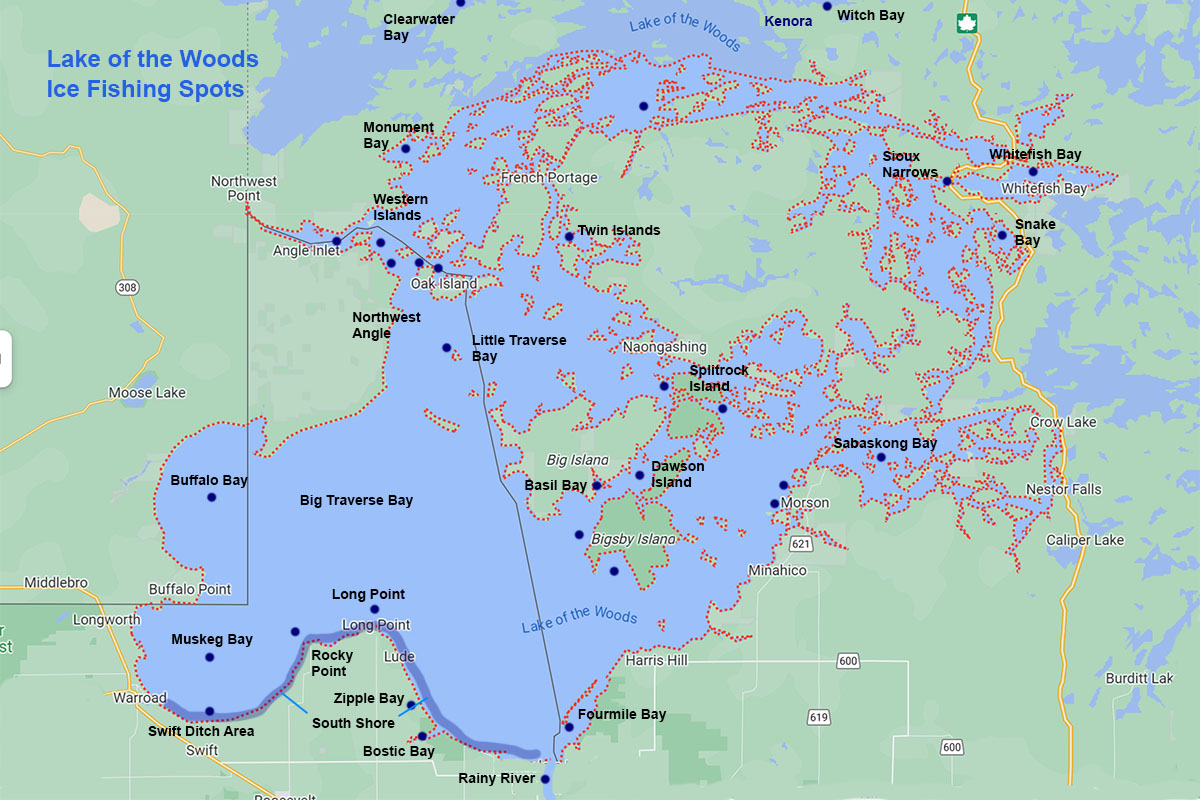
The big bays located along the southern and western regions of the U.S./Canadian border support some of the most productive fisheries on Lake of the Woods. These bays are ripe with rich vegetation and fish life. A couple of the more popular bays in this area for ice fishing are Muskeg Bay and Fourmile Bay. Both bays are accessible by ice road.
Rainy River is the major feeder into Fourmile Bay that provides over 70% of the water that flows into Lake of the Woods. Each winter this river freezes over and provides excellent ice fishing opportunities for a number of game fish species including predatory Northern Pike. Rainy River can be fished from the U.S. or Canada. As Rainy River freezes each year, game fish move down through its mouth pursuing schools of baitfish into Lake of the Woods.
One of the most famous and productive hard water fisheries on Lake of the Woods is the Northwest Angle. It covers a massive areas with includes over 14,000 islands. It offers a diverse underwater habit and topography with plenty of features and structures to support a plethora of fish life. Given its remote location, it experiences substantially less fishing pressure than the big bays to the south.
The Canadian counterpart to the Northwest Angle is The Eastern Islands. This area is somewhat remote and mostly uncharted, but it offers excellent fishing opportunities as well. The waters between the larger islands of Bigsby, Basil, Dawson and Splitrock hold abundant fish life. As with the Northwest Angle, The Eastern Islands experience relatively low fishing pressure compared to the Southern bays.
If you’re arriving at Lake of the Woods to fish Walleye, then join the club. Some of the more productive areas for fishing Walleye include Northwest Angle of course, the Western Islands, Fourmile Bay, Rainy River, South Shore, Kenora, Witch Bay, Clearwater Bay, Sioux Narrows, and Traverse Bay. These areas also hold a lot of Sauger.
Top spots for Northern Pike include the Southern Bays, Rainy River, Four Mile Bay, Bostic Creek, Zipple Bay, Twin Islands, Muskeg Bay, Rocky Point, Swift Ditch area, and Northwest Angle. Fish the deep pockets, transition zones, backwater, shallow bays with inlets, and always follow the Perch schools. Where there’s Perch there’s Pike.
If you’re interested in a little bass fishing, you’ll find abundant populations you should hit Patridge Bay, in the northwest (connected to Clearwater Bay), or Snake Bay, in the southest (connected to Whitefish Bay). You’ll find fish in the backs of the bays. Ice fishing here is best toward the end of winter when fish become more active feeders.
There are Crappie and Perch throughout Lake of the Woods, but you’ll find them in abundance in Northwest Angles and Rainy River.
Fishing License
Lake of the Woods is located in two countries and three states/provinces. The largest portion of the lake is located in Ontario Canada with smaller sections in the Canadian province of Manitoba and the U.S. state of Minnesota.
U.S. citizens can purchase a fishing license to fish the Minnesota side of the lake online from the Minnesota Department of Natural Resources. U.S. citizens wanting to venture into Canada to fish Lake of the Woods will need a Remote Area Border Crossing Permit, as well as an Ontario non-resident fishing license.
Regulations and Catch Limits
If you’re going to fish Lake of the Woods, it’s important to stay up to date on regulations and catch limits. Regulations can change so you’ll want to check before planning your next fishing trip. The most common regulations relate to catch and release and harvesting guidelines.
The are strict catch and release requirements for certain months of the year, while other months you’re free to harvest fish. These regulations will vary by fish species and license type–a Conservation License or Sport License. The following links provide up-to-date fishing regulations for Lake of the Woods.
- Baudette area fisheries – Select the “Lake of the Woods & Rainy River winter fishing (PDF) link in the “Seasonal fishing” section under in the “Resources” tab
- Ontario Fishing Regulations
- Manitoba Fishing Regulations
Rentals, Lodging & Accomodations
As one of the premier ice fishing destinations in the world, there are a number of outfitters, guides and resorts that make ice fishing on Lake of the Woods simple and comfortable. If it’s your first time to ice fishg Lake of the Woods I recommend going with someone who knows the lake, or hire the services of a guide. It’s a big lake, with a lot of ice to cover. You’ll have a better experience your first time going with someone with knows the lake. Wait ’till you second trip to go at it alone.
By mid December the ice is thick enough to walk on. By end of December you can usually start venturing out on ATV’s and snowmobiles, and constructing fish houses. By mid January the ice is thick enough to support side by sides, SUV’s and full size sleeper houses. Ice thickness and conditions vary from ice road to ice road and trail to trail. Make sure you know weight limitations and safety factors before venturing out on the ice.
If you want the ice fishing experience without the cold factor you can stay one of several local resorts. Resorts at Lake of the Woods cater to ice anglers. They offers 5-star heated transportation (GEO tracker) to fishing houses, monitor and maintain ice roads, and make your trip as carefree and smooth as possible. They can also hook you up with local guides that will show you ropes and ensure a productive ice fishing experience.
Best of all, when you’re done fishing, you done fishing. Head back to the resort with your catch and they’ll cook it up for you. After dinner it’s time for a hot shower and cozy bed.
If resort’n it is just a little too tame for your blood, you have the option of renting a sleeper fish house. It’s almost like ice camping, but without the wind chill. Sleeper fish houses keep you on the ice, fishing, experiencing nature 24/7. Regardless of the temperature outside, the temperature inside your fish house can be anywhere from a balmy 50 to 70 degrees. If you’ve ever wanted to ice fish in your pajamas, a fish house is the way to go. Most fish houses can be rented between 2-3 days, which is plenty of time to be on the ice and experience everything Lake of the Woods has to offer.


